Top 10 Historical Towers in China
For many travelers to China, traditional Chinese architecture has a fascination for them. And Chinese tower is a kind of very unique Chinese architecture. Here we list 10 famous Chinese towers you should never miss if you are interested in Chinese architecture.
1. Yellow Crane Tower 黄鹤楼 – Wuhan
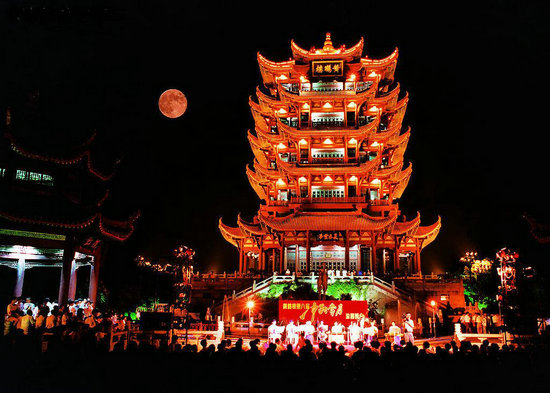 Yellow Crane Tower, located in Snake Hill in Wuchang, is a famous and historic tower. The tower was first built in 223 AD and the present building is a five-story building with a height of 50.4 meters. Standing on tower, people can enjoy the beautiful landscape of Wuhan as well as the remarkable Yangtze River.
Yellow Crane Tower, located in Snake Hill in Wuchang, is a famous and historic tower. The tower was first built in 223 AD and the present building is a five-story building with a height of 50.4 meters. Standing on tower, people can enjoy the beautiful landscape of Wuhan as well as the remarkable Yangtze River.
2. Tengwang Tower 滕王阁 -Nanchang
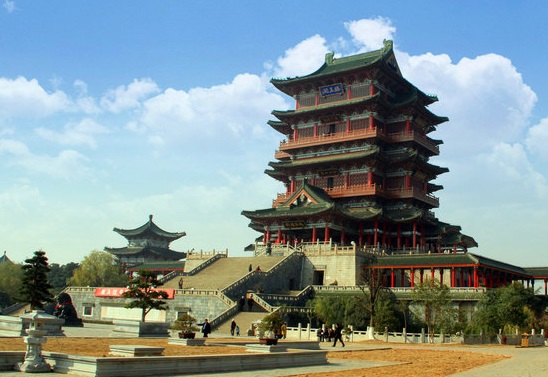 Tengwang Tower (or Tengwang Pavilion), located in Nanchang City, was first built in 659AD. The poem “Preface to Tengwang Tower” written by Tang dynasty (618-907AD) poet Wang Bo have made the tower famous. This nine-storied building stands 57.5 meters in height, featuring flying eaves and engraved beams, looks quite splendid.
Tengwang Tower (or Tengwang Pavilion), located in Nanchang City, was first built in 659AD. The poem “Preface to Tengwang Tower” written by Tang dynasty (618-907AD) poet Wang Bo have made the tower famous. This nine-storied building stands 57.5 meters in height, featuring flying eaves and engraved beams, looks quite splendid.
3. Guanque Tower (Stork Tower) 鹳雀楼 – Yongji
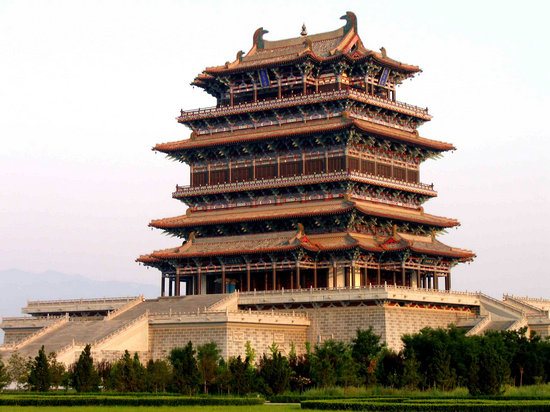 Guanque Tower (Stork Tower) was originally built in Bei Zhou (A.D.557-581). It is located in east bank of Huang River in ancient town Puzhou. Due to its delicate structure and superior location, the tower is known as one of the four famous ancient towers in China. The poem “On Guanque Tower” by famous Tang Dynasty poet Wang Zhihuan made the tower famous in China and abroad.
Guanque Tower (Stork Tower) was originally built in Bei Zhou (A.D.557-581). It is located in east bank of Huang River in ancient town Puzhou. Due to its delicate structure and superior location, the tower is known as one of the four famous ancient towers in China. The poem “On Guanque Tower” by famous Tang Dynasty poet Wang Zhihuan made the tower famous in China and abroad.
4. Yueyang Tower 岳阳楼 – Yueyang
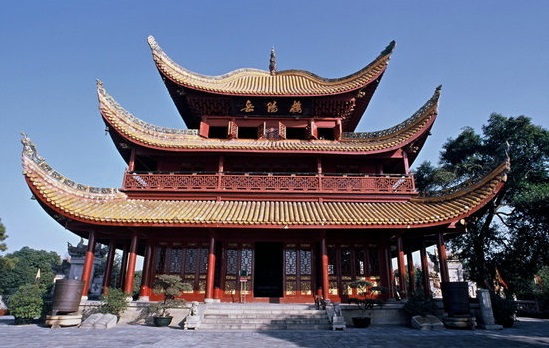 Yueyang Tower is located near the lakeside of Dongting in Yueyang City, Hunan Province. The tower is believed to be built more than 1,700 years ago during the Three Kingdoms Period. Yueyang Tower was made very famous by the Northern Song Dynasty poet Fan Zhongyan`s work “Memorial to Yueyang Tower”. Standing on top of the tower, people can enjoy beautiful scenery of Lake Dongting.
Yueyang Tower is located near the lakeside of Dongting in Yueyang City, Hunan Province. The tower is believed to be built more than 1,700 years ago during the Three Kingdoms Period. Yueyang Tower was made very famous by the Northern Song Dynasty poet Fan Zhongyan`s work “Memorial to Yueyang Tower”. Standing on top of the tower, people can enjoy beautiful scenery of Lake Dongting.
5. Yuejiang Tower 阅江楼 – Nanjing
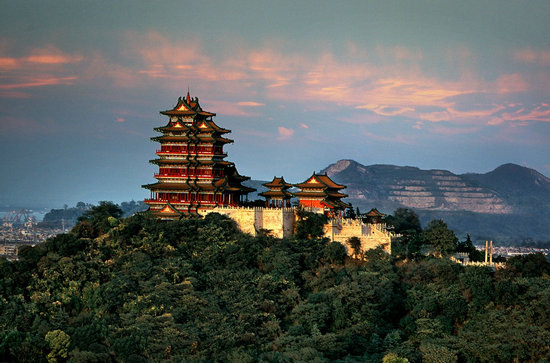 Yuejiang Tower sits on top of the Lion Hill near the banks of the Yangtze River in Nanjing City. Zhu Yuanzhang, the first emperor of Ming Dynasty ordered to build the Yuejiang Tower and wrote the “Note on Yuejiang Tower” in person. It is 52 meters high, with seven floors in total. Climbing up the tower, one can enjoy the Yangtze River as well as the scenery of Nanjing.
Yuejiang Tower sits on top of the Lion Hill near the banks of the Yangtze River in Nanjing City. Zhu Yuanzhang, the first emperor of Ming Dynasty ordered to build the Yuejiang Tower and wrote the “Note on Yuejiang Tower” in person. It is 52 meters high, with seven floors in total. Climbing up the tower, one can enjoy the Yangtze River as well as the scenery of Nanjing.
6. Xunyang Tower 浔阳楼 – Jiujiang
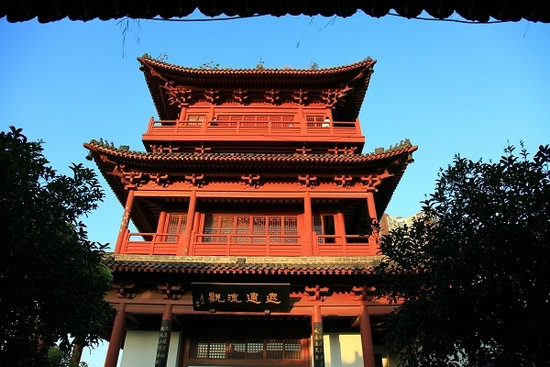 Located in Jiujiang City of Jiangxi Province, Xunyang Tower is widely known for vivid description of the famous classical Chinese novel “the Water Margin” by Shi Naian. The building was first built about 1200 years ago and the present building was rebuilt in 1989. The tower is 21 meters high and from the highest point of the pavilion one can gain great views across the lakes and landscape of Jiujiang.
Located in Jiujiang City of Jiangxi Province, Xunyang Tower is widely known for vivid description of the famous classical Chinese novel “the Water Margin” by Shi Naian. The building was first built about 1200 years ago and the present building was rebuilt in 1989. The tower is 21 meters high and from the highest point of the pavilion one can gain great views across the lakes and landscape of Jiujiang.
7. Guangyue Tower 光岳楼 – Liaocheng
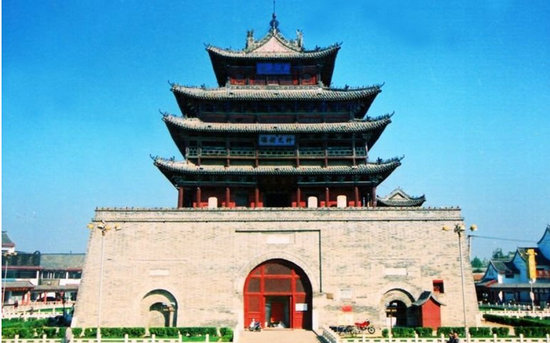 Originally built in A.D. 1374, Guangyue Tower is one of the most ancient wooden towers in China. It’s in the center of ancient urban district of Liaocheng. With 33 meters in height, the tower offers magnificent and splendid view and is the symbol of Liaocheng city. The Qing dynasty Emperor Kangxi visited the Tower for several times and left poems and handwriting here.
Originally built in A.D. 1374, Guangyue Tower is one of the most ancient wooden towers in China. It’s in the center of ancient urban district of Liaocheng. With 33 meters in height, the tower offers magnificent and splendid view and is the symbol of Liaocheng city. The Qing dynasty Emperor Kangxi visited the Tower for several times and left poems and handwriting here.
8. The Drum Tower of Xi’an 西安鼓楼 – Xi’an
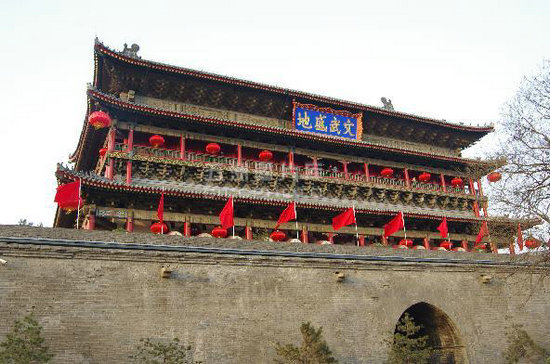 The Drum Tower of Xi’an stands at the heart of Xi’an city. The tower was built in 1380 during the early Ming Dynasty. It got its name from the huge drum located within the building and the drum was beat at sunset to indicate the end of the day. Inside the Drum Tower, there is also a drum museum, where a variety of drums is on display.
The Drum Tower of Xi’an stands at the heart of Xi’an city. The tower was built in 1380 during the early Ming Dynasty. It got its name from the huge drum located within the building and the drum was beat at sunset to indicate the end of the day. Inside the Drum Tower, there is also a drum museum, where a variety of drums is on display.
9. Jiaxiu Tower 甲秀楼 – Guiyang
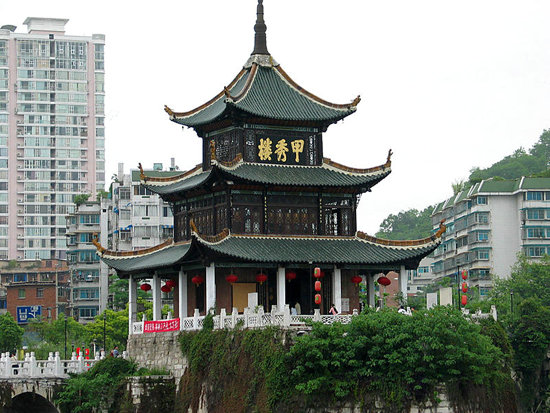 Jiaxiu Tower stands on the Nanming River, in Guiyang. The Tower is connected with the banks on both sides by Fuyu Bridge. This Chinese-style structure was built in 1597 in the Ming Dynasty. Inside Jiaxiu Tower, a precious collection of authentic works, colorful paintings, and ancient calligraphers was kept and on show.
Jiaxiu Tower stands on the Nanming River, in Guiyang. The Tower is connected with the banks on both sides by Fuyu Bridge. This Chinese-style structure was built in 1597 in the Ming Dynasty. Inside Jiaxiu Tower, a precious collection of authentic works, colorful paintings, and ancient calligraphers was kept and on show.
10. Yuewang Tower 越王楼 – Mianyang
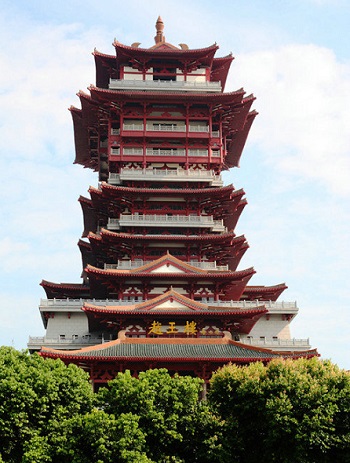 Yuewang Tower is located in Mianyang city, Sichuan Province. The tower was first built in the Emperor Gaozong of Tang Dynasty; it got its name from the local governor Li Zhen, the eighth some of Emperor Taizong.
Yuewang Tower is located in Mianyang city, Sichuan Province. The tower was first built in the Emperor Gaozong of Tang Dynasty; it got its name from the local governor Li Zhen, the eighth some of Emperor Taizong.

